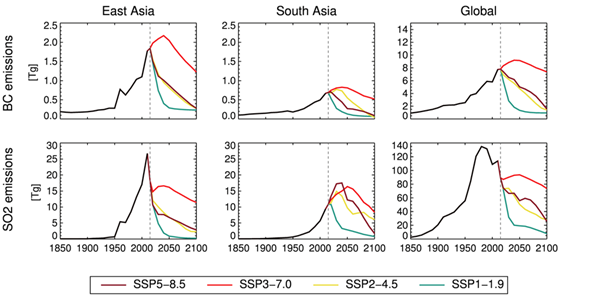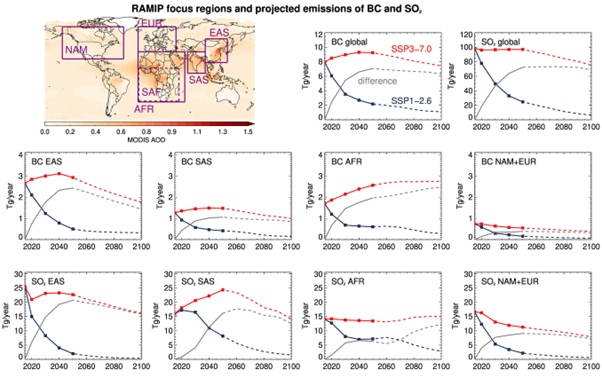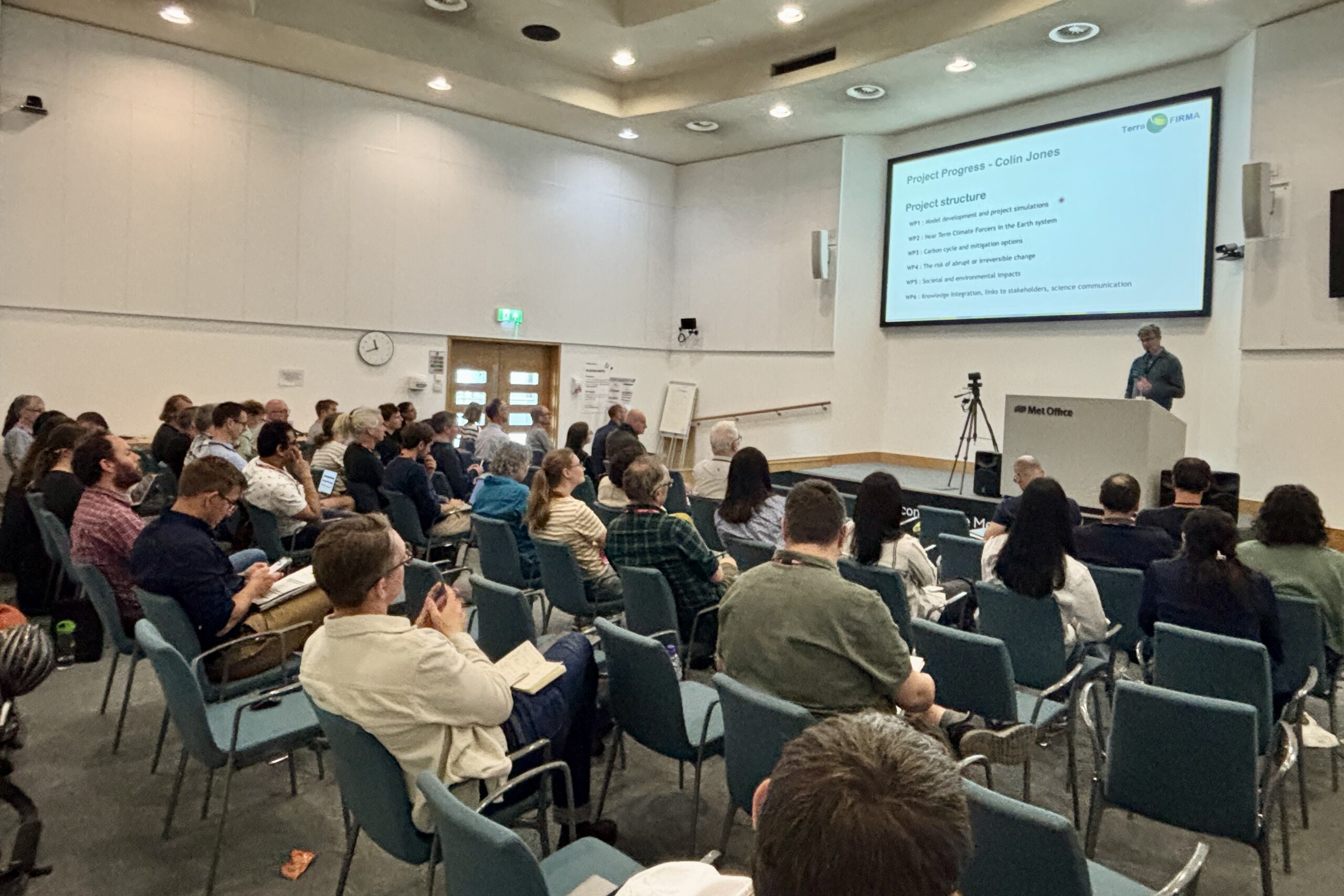News
Regional Aerosol Model Intercomparison Project
Laura Wilcox
NCAS, University of Reading
The cooling effect of aerosols means they have played an important role in climate change over the last 200 years, masking some of the warming caused by increases in greenhouse gases, and contributing to observed multidecadal variability. Because of their short atmospheric lifetime, most aerosols are found close to the regions where they were emitted. This is in marked contrast to most greenhouse gases, which have longer lifetimes and are thus more evenly distributed in the atmosphere. This regional heterogeneity makes aerosols very efficient at influencing circulation patterns, such as monsoons and the Atlantic Meridional Overturning Circulation. Although aerosols tend to stay close to their source, their influence on atmospheric circulation means that a change in aerosol emissions in one region can lead to impacts across the globe.
The short atmospheric lifetime of anthropogenic aerosols means reductions in emissions are quickly translated into reductions in atmospheric concentrations, and changes in impacts on air quality and climate. For example, increases in European aerosols through the 1970s are considered an important driver of decreased rainfall in the Sahel through the 1970s and 80s (Monerie et al. 2022) see Figure 1 below. As European emissions decreased following the introduction of the clean air acts in 1979, precipitation in the Sahel recovered, and the trend became more strongly influenced by greenhouse gas increases. Over the same period, the rate of increase of European temperatures accelerated as the cooling influence of anthropogenic aerosol decreased.
Figure 1 Sahel precipitation from observations (black) and CMIP6 simulations (colours), showing aerosol driving precipitation reductions from 1950 to 1980, and aerosol and greenhouse gases contributing to the subsequent recovery. Adopted from Monerie et al. (2022) – their Figure 2.
Poor air quality is a leading cause of premature mortality in countries such as India, where many of the world’s most polluted cities are currently found. In recent decades, China has dramatically reduced its aerosol emissions in an attempt to improve air quality, and other countries are expected to follow suit. However, the timing and rate of reduction of aerosol emissions are dependent on a complex combination of political motivation and technological capability. As a result, our projections of aerosol emissions over the next few decades are highly uncertain, making them a major source of uncertainty in near-future climate projections (Figure 2). Some scenarios see global aerosol emissions continue to increase in the near-future (e.g. SSP3-7.0), while in other scenarios they return to pre-industrial levels by 2050 (e.g. SSP1-2.6), meaning that the emission increases that took place over the last 200 years are reversed in just 20-30 years. While this would be a great outcome for the health of those living in regions with poor air quality, it may result in rapid climate changes, which need to be considered in adaptation and mitigation efforts.
Figure 2 Regional total black carbon (BC) and sulphur dioxide (SO2) emissions from 1850 to 2100 from the CMIP6 historical (black) and Shared Socioeconomic Pathways (SSPs) experiments (colours). Adopted from Wilcox et al. (2020) – their Figure S5.
In TerraFIRMA, we will be assessing the role of aerosols in the mitigation of future climate change and air quality. Much of our analysis will focus on South Asia, where we will assess the impact of different aerosol emission pathways on the monsoon, food security and marine ecosystems, and air quality. South Asia is a large source of ammonia, and interactions between ammonia and sulphur dioxide, mediated by nitrate aerosol, are a major source of uncertainty in regional aerosol forcing. TerraFIRMA will develop new capabilities for UKESM2, including interactive nitrate aerosol, and the impact of this on near-future projections will be tested.
But of course, UKESM is only one model, and it is not just the uncertainty in emissions that makes the role of aerosol in near-future projections uncertain, but the different ways that aerosols, and their interaction with climate, are parameterised in models. To take a broader perspective on the role of aerosol in near-future projections, we have designed a set of experiments that we hope will improve our understanding of the climate response to regional aerosol changes, provide a stronger link between emission policies and climate impacts, and support the development of more ‘aerosol-aware’ assessments of regional climate risk. The Regional Aerosol Model Intercomparison Project (RAMIP) includes experiments designed to quantify the effects of realistic, regional, transient aerosol perturbations on policy-relevant timescales, and to explore the sensitivity of these effects to aerosol composition.
RAMIP will focus on the effects of aerosol emissions from East Asia, South Asia, Africa and the Middle East, and North America and Europe, on climate projections to ~2050 (Figure 3). The first three regions have the largest emission uncertainty in the near-future. The uncertainty in North American and European emissions is smaller, but these midlatitude emissions are more effective at driving climate changes, so their influence on near-future changes may be comparable. RAMIP will use an SSP3-7.0 baseline, with sulphur dioxide, black carbon, and organic carbon emissions in following SSP1-2.6 emissions in each of the focus regions (plus a global perturbation experiment) in our Tier 1 experiments. Tier 2 experiments will explore the effects of East and South Asian emissions being reduced together, and isolate the role of different aerosol species, and the effect of including nitrate aerosol.
Figure 3 RAMIP focus regions and projected emissions of black carbon (BC) and the sulphate aerosol precursor gas sulphur dioxide (SO2). The first row shows the regions where East Asian (EAS), South Asian (SAS), and African and Middle Eastern (AFR) emissions will be perturbed, and 2015 aerosol optical depth at 550nm from MODIS, and timeseries of total global BC and SO2 emission rates from SSP3-7.0 (red) and SSP1-2.6 (navy), and the difference between them (grey). The second row shows BC emission rates for the three regions, and the third row shows SO2 emission rates for the three regions. Reproduced from Wilcox et al. (2022) – their Figure 2.
As RAMIP is intended to link regional emissions and regional climate responses, we have requested a minimum of 10 ensemble members per experiment from participating centres. In addition to a range of monthly diagnostics, we will be archiving daily data to study temperature and precipitation extremes, air quality, and blocking events. Simulations are just getting underway now, but we expect to have a full set of Tier 1 experiments from 9 models by spring 2024, with CMORized data publicly available via CEDA in early 2025. TerraFIRMA and UKESM collaborators wishing to access the data before this date can email ramip@ncas.ac.uk.
For more details of the RAMIP experiment design, see the preprint of our experiment description paper in GMD. For more thoughts on aerosol and climate risk assessments, see our recent review, and related comment.
References:
Monerie, P., L. J. Wilcox, and A. G. Turner, 2022: Effects of Anthropogenic Aerosol and Greenhouse Gas Emissions on Northern Hemisphere Monsoon Precipitation: Mechanisms and Uncertainty. J. Climate, 35, 2305–2326, https://doi.org/10.1175/JCLI-D-21-0412.1.
Persad, G. G., Samset, B. H. and Wilcox, L. J. (2022) Aerosols must be part of climate risk assessments. Nature, 611. pp. 662-664. ISSN 0028-0836 doi: https://doi.org/10.1038/d41586-022-03763-9
Persad et al 2023 Environ. Res.: Climate 2 032001, doi: 10.1088/2752-5295/acd6af
Wilcox, L. J., Liu, Z., Samset, B. H., Hawkins, E., Lund, M. T., Nordling, K., Undorf, S., Bollasina, M., Ekman, A. M. L., Krishnan, S., Merikanto, J., and Turner, A. G.: Accelerated increases in global and Asian summer monsoon precipitation from future aerosol reductions, Atmos. Chem. Phys., 20, 11955–11977, https://doi.org/10.5194/acp-20-11955-2020, 2020.
Wilcox, L. J., Allen, R. J., Samset, B. H., Bollasina, M. A., Griffiths, P. T., Keeble, J. M., Lund, M. T., Makkonen, R., Merikanto, J., O’Donnell, D., Paynter, D. J., Persad, G. G., Rumbold, S. T., Takemura, T., Tsigaridis, K., Undorf, S., and Westervelt, D. M.: The Regional Aerosol Model Intercomparison Project (RAMIP), Geosci. Model Dev. Discuss. [preprint], https://doi.org/10.5194/gmd-2022-249, in review, 2022.





